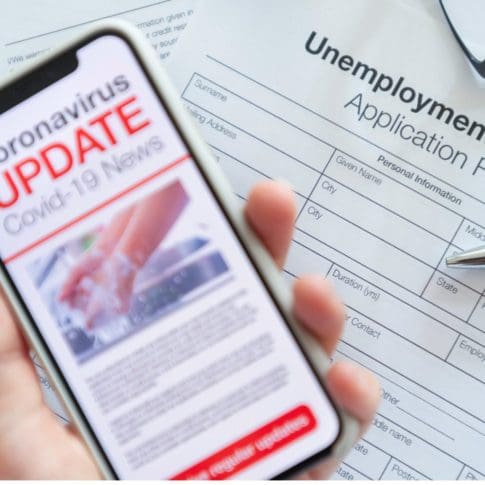Updated on August 6, 2020 with up to date PUA payment start dates.
The rapid contraction of the economy this spring has shattered records for the speed of onset of a recession. Tens of millions of jobs evaporated nearly overnight, output fell rapidly, and personal incomes took a major hit. Congress quickly stepped in with support, spending nearly $3 trillion on a host of programs to provide public health and economic support at the onset of the pandemic. One of the most economically important pieces of that policy support has been the rapid expansion of unemployment insurance (UI). Our preliminary calculations suggest that UI offset a small portion of personal income loss in March 2020, but roughly half of lost wages and salaries in April.
In late March, Congress expanded eligibility to workers who were not previously covered (Pandemic Unemployment Assistance, or PUA), added a $600 per week pandemic payment to all UI checks (Pandemic Unemployment compensation, or PUC), and extended the maximum length of time a person can receive UI benefits by 13 weeks.
In April, the states and federal government paid out $48 billion in UI benefits, but even this was not enough to keep up with the increase in joblessness. Administrative challenges and failures by some state systems have slowed the flow of UI payments to many eligible recipients, leaving them stranded without income. In this analysis, we examine the rapid fall in personal income, contrasting it with the large increase in UI payments that has partially offset the decline.
In March of 2020, when unemployment levels had just started to rise, there was a sizable jump in UI payments made by the U.S. Treasury: they rose from $3.0 billion in February to $4.2 billion in March. In the monthly personal income data from the Bureau of Economic Analysis, UI payments showed the largest ever one-month jump in the 60 years since data have been collected. Still, the increase in UI payments offset less than 15 percent of the drop in wage and salary personal income over the same period.
The size of the wage and salary income reduction in April 2020 will not be known until late May, but it is possible to very roughly calculate that decline using available data. Doing so allows a preliminary assessment of the share of the decline that was offset by UI spending in the same month. This calculation is a straightforward one: we multiply average weekly private wage and salary earnings in February by total payroll employment in that month, do the same for April, and then calculate the percent reduction from February to April.
That calculation indicates that April’s income fell roughly 12 percent below the pre-crisis level. If private wages and salaries (as reported by BEA) were to fall by the same percent, that would leave a roughly $80 billion hole in monthly personal incomes in April. (Note that government wages and salaries fell as well, as did proprietor’s income, meaning the personal income loss was likely even larger than this suggests.)
In the early days of the crisis, UI payments were only offsetting a small portion of the personal income decline. One reason is that most of those who filed new claims for unemployment insurance in late March were not yet receiving payments in March. In fact only 1.7 million new recipients were reported in March, compared with the 9.4 million initial claims filed during March and the 8.2 million continued claims reported in the final week of March (i.e., total claims filed by individuals during each week of unemployment after an initial application). (Throughout this post, we report non-seasonally adjusted claims.) Furthermore, as the programs were only just created at the end of the month, no states had yet implemented the PUA program for traditionally ineligible individuals and none were paying the additional $600 PUC payments to recipients who qualified under standard state rules (see figure 1).
 As figure 1 shows, by the end of April, all states were paying the $600 weekly payments. However, it has taken substantially longer for states to build systems to accommodate the expanded eligibility under PUA. By the week ending April 25, only 12 states, making up 29 percent of the labor force, were paying out PUA benefits. By the week ending May 16, it is likely that 39 states and the District of Columbia were paying out benefits. (See appendix table 1 for PUC and PUA implementation dates by state.)
As figure 1 shows, by the end of April, all states were paying the $600 weekly payments. However, it has taken substantially longer for states to build systems to accommodate the expanded eligibility under PUA. By the week ending April 25, only 12 states, making up 29 percent of the labor force, were paying out PUA benefits. By the week ending May 16, it is likely that 39 states and the District of Columbia were paying out benefits. (See appendix table 1 for PUC and PUA implementation dates by state.)
The combination of PUC and PUA benefits, along with the continuing surge of unemployment claims, led to total UI payments of over $48 billion from the Treasury during the month of April—the equivalent of more than 3 times more than paid out at the monthly peak of the Great Recession (after adjusting for inflation). ($27 billion of the April spending was accounted for by the $600 PUC benefit increase.) The unemployment system has sent out more money in April of 2020 than it did in the first four months of 2009 during the Great Recession. Weekly UI payments were still rising at the end of April and through the early weeks of May (see the dark green line in figure 2) as more states began sending payments to newly eligible participants and continued to make $600 PUC payments.
 UI spending during April 2020 rose by $45 billion over its February level, offsetting just over half of the (estimated) private wages and salary loss. This UI offset was far larger than in March, has been essential to families, and is vital for keeping the economy from cratering further, but it still paled in comparison to the income losses in the economy. During normal times, unemployment insurance does not entirely replace total income losses because replacement rates—the share of a worker’s prior income that UI pays as benefits—generally range from 30–55 percent. Moreover, many of the unemployed are typically ineligible for UI or do not participate. But the CARES Act changed both of these factors. The addition of the $600 per week PUC bonus substantially increased replacement rates, lifting them above 100 percent for some low-wage workers, and PUA further expanded UI eligibility.
UI spending during April 2020 rose by $45 billion over its February level, offsetting just over half of the (estimated) private wages and salary loss. This UI offset was far larger than in March, has been essential to families, and is vital for keeping the economy from cratering further, but it still paled in comparison to the income losses in the economy. During normal times, unemployment insurance does not entirely replace total income losses because replacement rates—the share of a worker’s prior income that UI pays as benefits—generally range from 30–55 percent. Moreover, many of the unemployed are typically ineligible for UI or do not participate. But the CARES Act changed both of these factors. The addition of the $600 per week PUC bonus substantially increased replacement rates, lifting them above 100 percent for some low-wage workers, and PUA further expanded UI eligibility.
Figure 2 shows that, in the current crisis, UI imperfectly offset personal income losses, due in large part to a different factor: the temporary inability to make the full payments owed to recipients. If UI payments had been made as soon as unemployment insurance claims were reported as “continuing claims”, total UI payments would have been quite higher, roughly $32 billion more in the first four weeks of April than was actually paid. (However, this estimate is imprecise. On one hand, it is likely an overestimate of potential payments, given that historically not all continued claims ever lead to payments and we have assumed that all continued claims could result in $1,000 payments per week. On the other hand, it may undercount potential benefits because it does not include expanded eligibility.)
As depicted in figure 2, the difference in actual payments (dark green line) relative to potential payments (as derived from continued claims and shown in the light green line) is in part driven by delays in getting payments to recipients, especially PUA payments. But in addition to these delays, there are other ways in which the UI does less than it could in the current recession. Many people simply have not filed for unemployment insurance due to either a lack of awareness or because of the difficulties in accessing state UI systems. There were 23 million people reported as unemployed in the Bureau of Labor Statistics’ Employment Situation for April 2020. If those people received average UI payments for the full month, the total of UI payments would have been over $90 billion, roughly double what was actually paid out. UI has been crucial for many people, but it clearly did not reach all who needed it in April.
Unemployment insurance is not the only program helping American families. Safety net programs like SNAP continue to support the most vulnerable, but federal SNAP payments have only increased 2.2 billion in April over February. The direct stimulus payments ($1,200 each for most adults) are very substantial—monthly personal income may actually increase in April, not decrease—but those stimulus payments are one time only and should not be thought of as filling an ongoing monthly loss of personal income.
For workers, families, and the economy as a whole, unemployment insurance has been a critical component of the economic policy response to the crisis. However, the UI system has been able to do this in large part because of legislated expansions that are all set to expire over the next few months: The $600 PUC bonus payments end abruptly on July 31 when the Congressional Budget Office (CBO) projects that the unemployment rate will exceed 15 percent. Expanded UI eligibility (PUA) expires at the end of the year when CBO projects the national unemployment rate will still be in double digits. In order for UI to continue helping to fill the gap in household budgets, it will be essential that eligible individuals are actually able to receive their UI payments. But it will also be critical that new UI provisions allowing for expanded benefits are maintained according to economic data rather than arbitrary timelines.
The authors thank Lauren Bauer, Kriston McIntosh, Jimmy O’Donnell, and David Ratner for helpful feedback. Jimmy O’Donnell and Caroline Carpenter provided invaluable research assistance.
Appendix Table 1.
Pandemic Unemployment Compensation and Pandemic Unemployment Assistance Implementation Dates, by State
| State |
Date PUC Payments First Made |
Date PUA Applications were First Processed |
Date PUA Payments were First Made |
| Alabama | |||
| Alaska | |||
| Arizona | |||
| Arkansas |
5/21/2020*** |
||
| California | |||
| Colorado | |||
| Connecticut |
5/7/2020*** |
||
| Delaware | |||
| District of Columbia |
5/5/2020** |
||
| Florida | |||
| Georgia | |||
| Hawaii |
5/18/2020*** |
||
| Idaho |
No information available |
||
| Illinois |
5/18/2020** |
||
| Indiana | |||
| Iowa |
No information available |
||
| Kansas | |||
| Kentucky |
6/12/2020** |
||
| Louisiana |
No information available |
||
| Maine | |||
| Maryland | |||
| Massachusetts | |||
| Michigan | |||
| Minnesota |
No information available |
||
| Mississippi |
4/28/2020** |
||
| Missouri | |||
| Montana | |||
| Nebraska |
No information available |
||
| Nevada | |||
| New Hampshire |
No information available |
No information available |
|
| New Jersey |
No information available |
||
| New Mexico |
5/3/2020** |
||
| New York |
4/27/2020** |
||
| North Carolina | |||
| North Dakota | |||
| Ohio |
5/26/2020*** |
||
| Oklahoma |
4/26/2020*** |
||
| Oregon |
5/5/2020** |
||
| Pennsylvania |
5/7/2020*** |
||
| Rhode Island |
4/13/2020*** |
||
| South Carolina | |||
| South Dakota | |||
| Tennessee |
No information available |
||
| Texas |
4/12/2020*** |
||
| Utah | |||
| Vermont | |||
| Virginia |
No information available |
||
| Washington | |||
| West Virginia |
No information available |
||
| Wisconsin | |||
| Wyoming |
5/5/2020*** |
||
| *Date reported as accepting applications, which may be distinct from processing **PUA payment date imputed, assumes payments go out 7 days after first processing date. ***PUA payment date is sourced from correspondence with state officials |
|||
| Note: Table is up to date as of August 5, 2020 | |||



